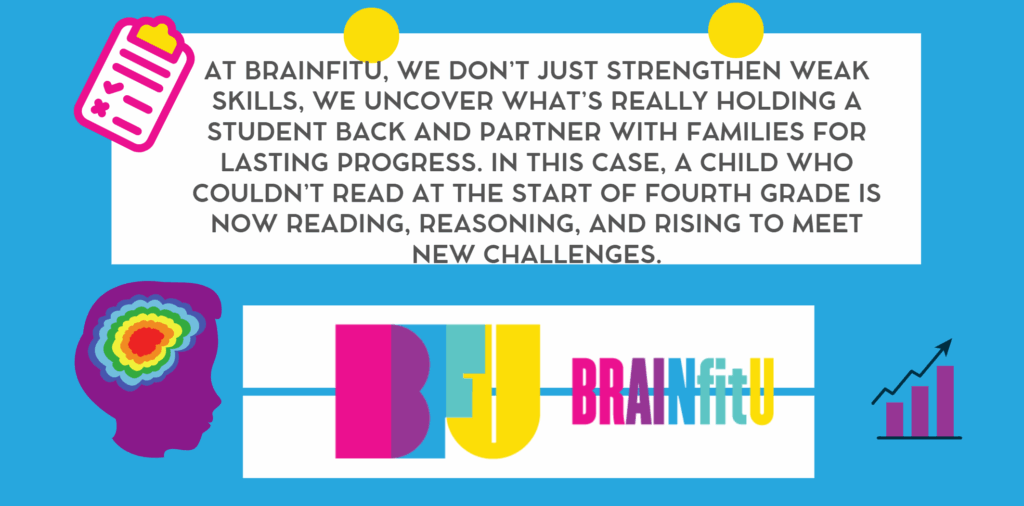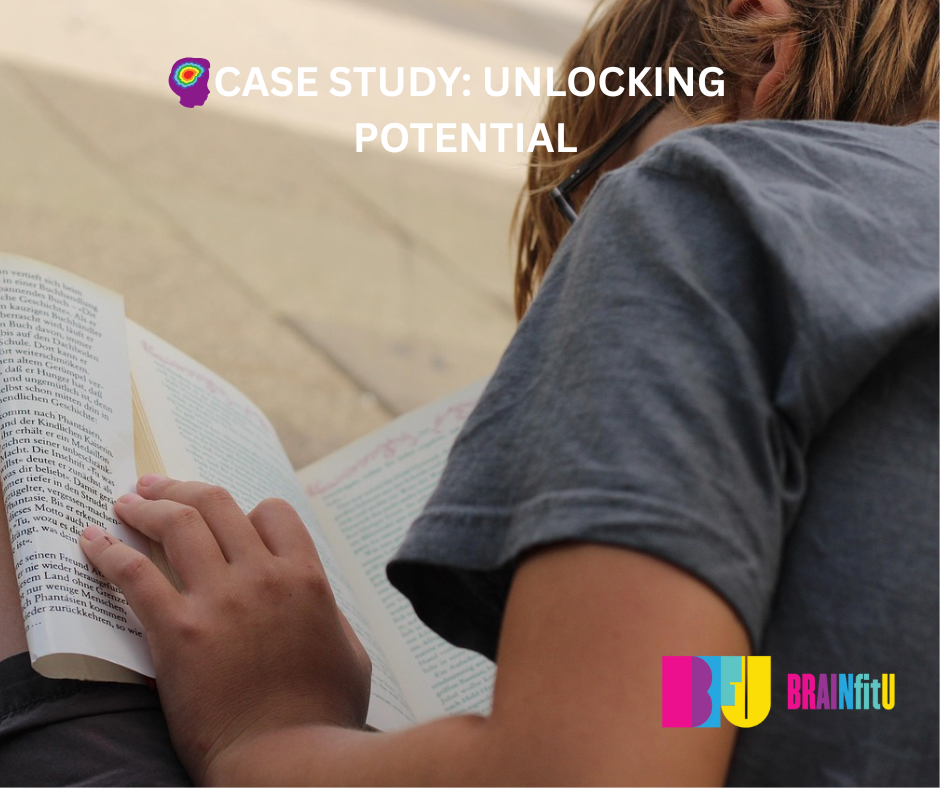By: Daisy Watson
What do you do when tutoring is not enough? You know your student can learn but something is missing.
Background
This case study follows a male student in upper elementary school who enrolled in BRAINfitU and has been in the program for five months. When he first arrived, his assessments revealed significant challenges in memory, processing, attention, auditory processing, and word attack skills. Despite these low scores, the BRAINfitU team recognized his untapped potential and began investigating possible underlying factors.
Challenges
- Slow processing speed
- Difficulty with transitions
- Working memory delays
- Needed vision therapy unbeknownst to his family or school staff, and non-reader at program entry
His parents knew something was wrong, but hadn’t been given clear answers or support.
When this student began training at BRAINfitU, he was entering fourth grade unable to read and without any formal diagnosis or access to special services. His parents knew something was wrong, but hadn’t been given clear answers or support.
Despite being bright and curious, he faced daily frustration. Tasks involving basic math facts and sustained attention overwhelmed him. He would frequently stall mid-task, struggle to retain instructions, and disengage due to fatigue. To outside observers, teachers, classmates, even family, it might have looked like he was lazy or unmotivated, but in reality he was battling skill gaps that made these tasks far harder than they appeared. Yet it was clear: he wanted to succeed.
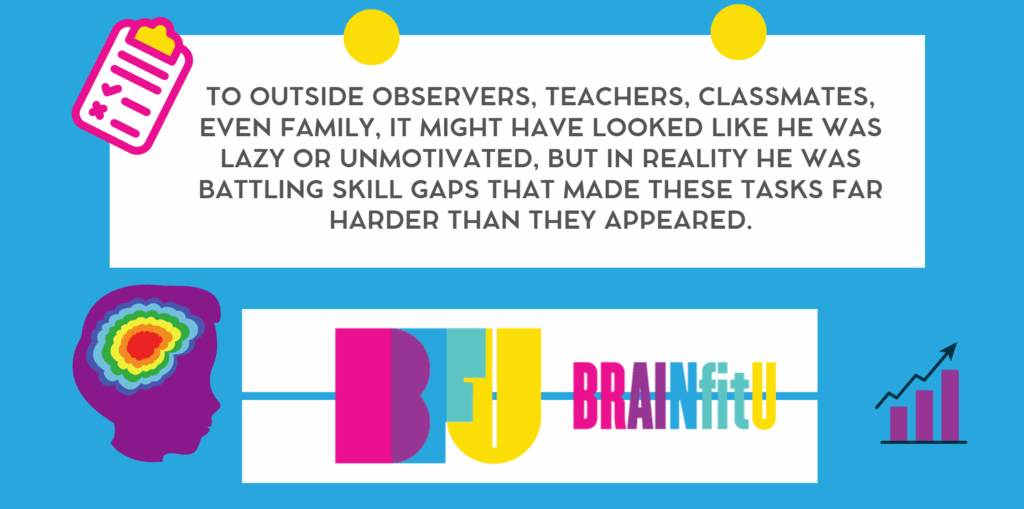
Individual Assessment
At BRAINfitU, every learner begins with a comprehensive, individualized assessment designed to uncover both challenges and hidden strengths. This approach ensures we’re not just identifying where a student struggles we’re revealing what will most effectively support their growth.
Thanks to BRAINfitU’s comprehensive assessments, one of the first major breakthroughs came from uncovering and addressing significant vision challenges. Chart 1A shows the pretest that BrainfitU completed showing very low scores in many of the memory areas as well as processing and attention skills. He scored low in auditory processing and word attack. The Director of Brainfitu knew that these scores were not indicative of what this child could do. She referred him for vision therapy.

After the vision challenges were addressed, the student’s ability to recognize letters and numbers improved dramatically, laying the groundwork for broader cognitive development. Without BRAINfitU’s thorough assessment, this vision deficit could have gone unnoticed, continuing to hinder progress. Chart 2A highlights the remarkable improvements seen after vision therapy. With this updated information, BRAINfitU was able to tailor a cognitive training plan specifically targeted to the student’s needs.

Key Areas of Focus
Processing Speed
The student often experienced “brain freeze” moments not due to distraction, but actual cognitive stalls. Even when he knew an answer, retrieving it was a slow, exhausting process for him. He’d sometimes drop his pencil or stare at the page without moving forward.
Attention and Focus
Exercises could be especially difficult. Simple facts like 3 + 5 were confusing not because he didn’t know the answer, but because his brain struggled to access the information fast enough.
Emotional Response to Challenge
At first, frustration ruled.
He felt behind and defeated. But as training progressed, he began to take ownership of his growth. He would ask to reattempt challenges, set personal goals, and celebrate small wins. This mindset shift was just as important as the academic gains.
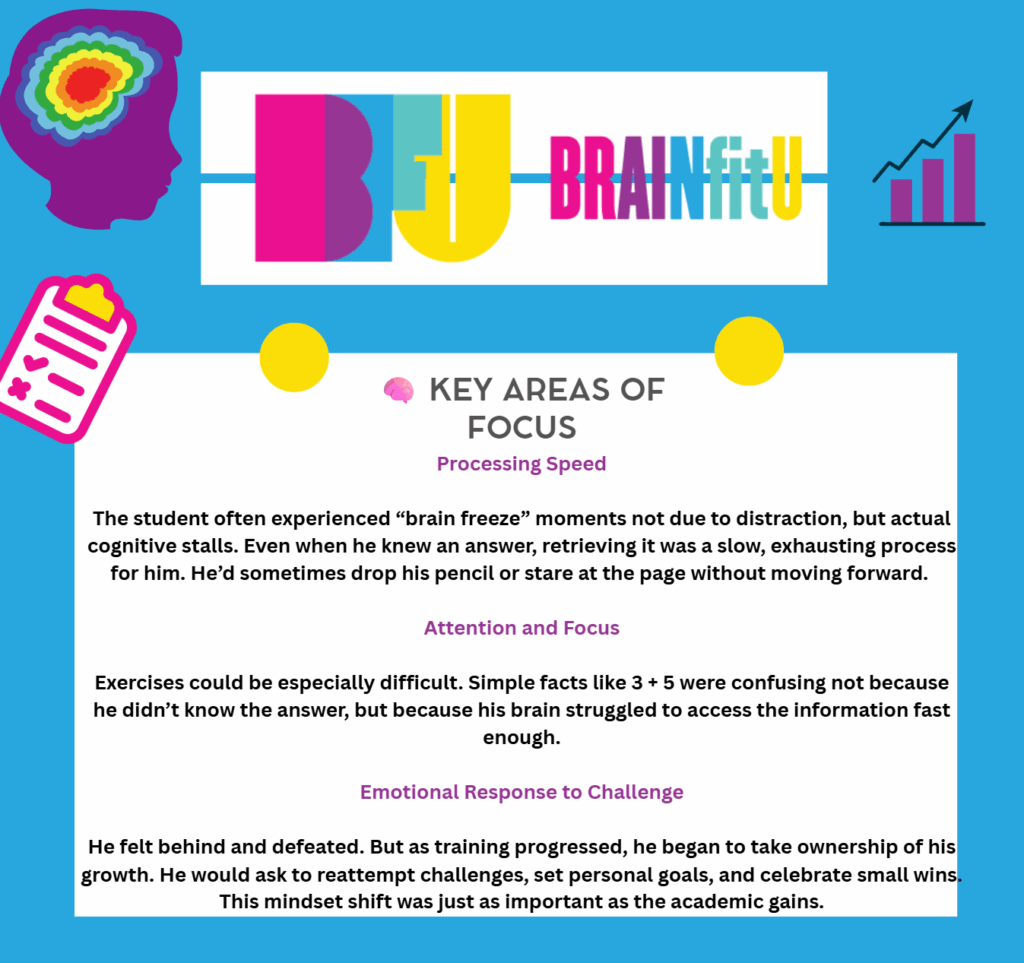
The BRAINfitU Approach
BRAINfitU’s strength-based, personalized model made a big difference. His trainer adapted sessions in real-time to support his stamina and engagement. Some areas that assisted him in his brain training included:
- Tackling the hardest tasks early, when his focus was sharpest
- Alternating between taxing and lighter exercises to manage mental fatigue
- Using logic-based work to build flexible thinking and support processing
- Delaying dual-task exercises until speed and confidence were stronger
- Balancing prompts while not giving him cognitive overload
From Struggles to Strengths
The transformation the student had was observed by his trainer, his parents and his teachers:
✅ Math
A breakthrough in fluency.
✅ Logic
Advanced from early struggles to higher levels, demonstrating growth in reasoning and critical thinking.
✅ Auditory & Visual Memory
Significant improvement in both enabling better classroom follow-through and reading comprehension.
✅ Processing Pauses
Still present but much less frequent. Transitions between tasks are smoother, and his mental endurance is stronger. This will continue to improve as the gaps he had get smaller and smaller.
Chart 3A shows the students major changes from being Very Low and Low in all areas to only being Low in Processing speed. His Memory and Logic-Reasoning skills, went all the way to Superior scores, his visual processing went to Above Average. His Auditory Processing and Word Attack are now high, making it so that he hears the words and understands the sounds, previously when he heard sounds they were not making sense to him to be able to decode new words. It was no wonder he could not read! His attention composite went to Above Average making it so that his attention and ability to focus to stay on task are highly increased. These results make his trainers smile ear to ear!
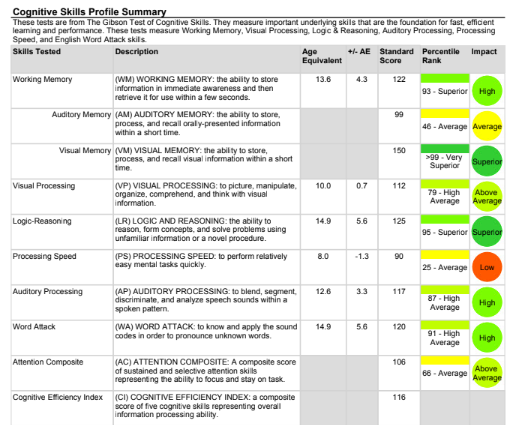
After completing both vision therapy and one-on-one cognitive training with BRAINfitU, the student demonstrated remarkable gains across multiple skill areas. Chart 4A highlights this dramatic progress, showing how step-by-step intervention can unlock new capabilities. By addressing each piece of the learning puzzle in sequence, BRAINfitU helped transform underlying weaknesses into strengths and create a solid foundation for ongoing success.
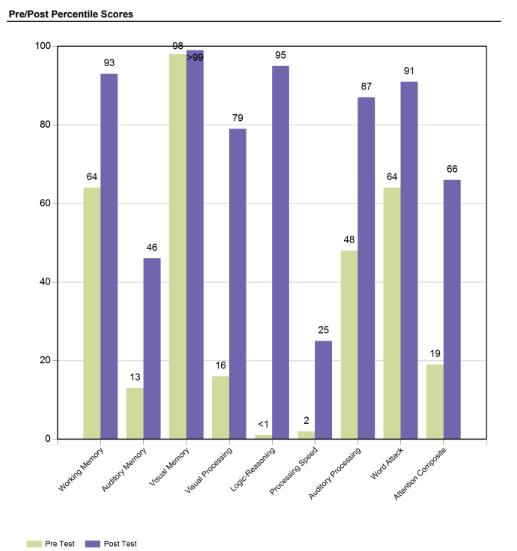
Parent Commitment & Continued Growth
Seeing his growth, his family chose to extend training beyond the original suggested 5 months. They recognized that real change takes time and that cognitive training was giving him the foundation that traditional instruction had not. When school started in the fall his mother continued to work on specific exercises with him to keep his positive results working for him.
He still has a journey ahead, but now he’s equipped with tools, strategies, and growing confidence. For the first time, school feels possible.
A Future with Confidence
This student’s story is a powerful reminder: not every struggling learner has a diagnosis but every learner deserves support.
At BRAINfitU, we don’t just strengthen weak skills, we uncover what’s really holding a student back and partner with families for lasting progress. In this case, a child who couldn’t read at the start of fourth grade is now reading, reasoning, and rising to meet new challenges.
The best part? He’s just getting started.
